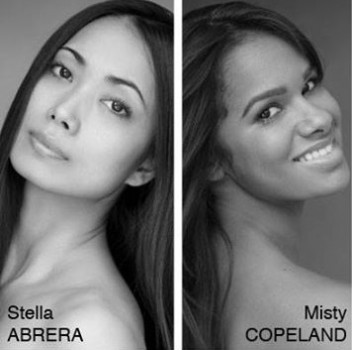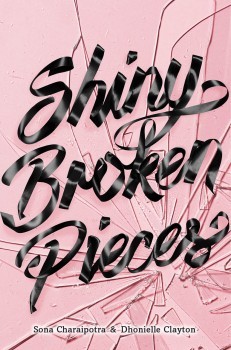Tiny Pretty Things

When I finished reading Tiny Pretty Things last summer, I had some questions for Dhonielle Clayton and Sona Charaipotra . They are VERY busy women, but they kindly agreed to take time out of their schedules to answer three pressing questions for me—read on!
ME: I have to say, I was never really interested in ballet until I read your novel! Its release coincided with the ABT’s appointment of Misty Copeland and Stella Abrera as principal dancers, and this happened around the same time that another Black woman athlete (Serena Williams) was being publicly criticized for not being “feminine enough.” Can you talk about your intent in making two of the three lead characters teenage girls of color? Misty has been told she’s “too athletic” but your characters seem to “fit in” rather that pushing against the mold. Did you want your characters of color to disrupt traditional ballet messages and/or images of femininity?
D&S: We were definitely very deliberate in making two of the three protagonists in TINY PRETTY THINGS people of color. That’s CAKE Literary’s mission: to make delicious page turners with a deep, organic layer of diversity to them. The idea is that the diversity is not the plot, but definitely affects the plot. In the world of pre-professional ballet — a world Dhonielle witnessed firsthand while teaching at a ballet conservatory — that diversity already exists, and we decided to stay true to the diversity that really does exist and exalt it. (Rather than say, forcing an Indian girl into that picture because that is Sona’s own background.) There are dancers of color competing at this level, and the experience is certainly different and sometimes difficult for them. We decided to reflect on the racism and microaggressions these dancers of color experience in this world, and to let their backgrounds permeate their experience and worldview. Regarding the idea of a dancer of African-American descent being “too athletic,” that is quietly explored in TPT as well — as Gigi faces comments about her thighs and body type, etc., within the judgments made against her (and internalizes some of these judgments herself). Then there’s the idea that she’s the “flavor of the month” for Mr. K, the creative director, but also that she doesn’t fit the traditional Ballet Blanc ideal. And the idea that Asian dancers are often cast to the side is definitely something June’s experience comments on — she’s neither here nor there, racially, emotionally, casting-wise, so she’s a bit untethered. Both her fellow students and the instructors at the conservatory don’t know quite which box to put her in.
 There is this idea of the Ballet Blanc that remains the default to this day. Hopefully, with strides made by dancers like Misty Copeland, Stella Abrera and Hee Seo, this will begin to shift. In this, we’re hoping that TPT reflects a reality, and further propels/normalizes that shift.
There is this idea of the Ballet Blanc that remains the default to this day. Hopefully, with strides made by dancers like Misty Copeland, Stella Abrera and Hee Seo, this will begin to shift. In this, we’re hoping that TPT reflects a reality, and further propels/normalizes that shift.ME: I was really interested in the way you used Henri to menace Bette, though I was troubled at times by his behavior. Were you worried about making him seem like a sexual predator or were his actions “justified” by Bette’s abuse of Cassie? You made sex complicated in this novel; are teen readers ready for that level of complexity?
D&S: Henri’s approach to his revenge on Bette is meant to be troubling. His menace is practiced to the point of being almost casual, and that’s meant to disturb both Bette and the reader. I definitely don’t personally see his actions as justified in any way, and the particular scenes you reference are meant to be intimidating and scary. Yes, Bette’s done some very horrifying things herself, but Henri’s retaliation isn’t justified by it — and I think the power dynamic, in what he knows, and in his sheer strength, is meant to worry the reader. He holds something over her, so she’s afraid to speak out, and she also ponders her own power in this situation. This is reflected in her attempts to use that power in handling her problems with Mr. K. She thinks she knows what she’s doing, but she really has no clue, and I think that’s very teen of her. I think the sad reality is that many teen readers probably understand too well the dynamics at play here, how messed up they are, how she is a victim while also being a villain (in her bullying). It’s meant to make you feel conflicted and to make you think, since female bodies are so much front and center in this world — objects to be commented on, owned and manipulated on so many levels.
ME: Many Black artists have argued that their goal is to represent the full spectrum of Black humanity without worrying about confirming stereotypes or offering only “positive” representations of the race. With your three main characters, were you consciously exploiting or working against stereotypes? Why do we need representations of “mean girls” who aren’t only white?
 D&S: We were quite deliberate in this as well — we didn’t want to represent the “angry black girl” or the “demure Asian girl,” so we began with turning those tropes around. People frequently say June is probably the most messed up of the characters in the book — but let’s be real, we were pretty equal opportunity on that front. We wanted her to be first and foremost an interesting, complex character — someone you maybe love to hate, but someone you also feel for. Yes, she’s Asian, and so much of her emotional deficit comes from her in-between space, the racism she faces, the lack of information about who she is, the remove she often feels from the culture she’s meant to be a part of. So race informs her, certainly. But so too does experience. Gigi is meant to represent an upper middle class African-American girl who’s had a somewhat privileged, sheltered experience till now — someone we don’t see all that often in teen fiction, but who certainly exists.
D&S: We were quite deliberate in this as well — we didn’t want to represent the “angry black girl” or the “demure Asian girl,” so we began with turning those tropes around. People frequently say June is probably the most messed up of the characters in the book — but let’s be real, we were pretty equal opportunity on that front. We wanted her to be first and foremost an interesting, complex character — someone you maybe love to hate, but someone you also feel for. Yes, she’s Asian, and so much of her emotional deficit comes from her in-between space, the racism she faces, the lack of information about who she is, the remove she often feels from the culture she’s meant to be a part of. So race informs her, certainly. But so too does experience. Gigi is meant to represent an upper middle class African-American girl who’s had a somewhat privileged, sheltered experience till now — someone we don’t see all that often in teen fiction, but who certainly exists.
Thanks, ladies! You can learn more about Dhonielle, Sona, and CAKE Literary here, and look for the sequel Shiny Broken Pieces next summer…



